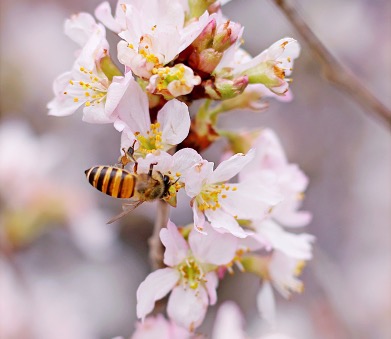What happens in the hive in winter?
This phase can last between three and six months, it generally begins at the end of the honey flows. The activity is then reduced considerably, the queen then stops laying eggs and the colony fills up in clusters. She will live on the reserves of honey left by the beekeeper and will protect herself from the cold by regulating the temperature of the hive. The bee population will decrease slightly throughout this phase
When a nice day comes, the bees that are confined to the hive take the opportunity to steal property.
Above all, the hive must not be disturbed because the most dangerous thing for the bees at this time is the humidity, which promotes the emergence of diseases.

Bees live on their honey supply
What happens in the hive in the spring?
As soon as the first flowers appear, the foragers resume activity.
The queen will thus begin to lay again gradually depending on the pollen potential necessary for the growth of the larvae and the climatic conditions.
In view of the low quantities of nectar collected at the start of the season, the reserves will decrease considerably. In case of prolonged bad weather, famine can occur.
The old bees that ensured the survival of the colony in winter will gradually disappear to allow a renewal of the colony.
With the arrival of abundant flowering, the queen will lay eggs at a high rate of up to 2000 eggs per day to ensure maximum foraging. As a result, the population is growing very quickly.
The new foragers will thus ensure the summer harvests, the drones (the males) and the new ones appear and can cause natural swarming.
The first harvests can be provided from spring depending on flowering and surrounding crops.

A bee foraging in the spring
What happens in the hive in summer?
Depending on floral availability, this period begins more or less early.
The numbers of foragers is at the maximum, any source of nectar is visited.
The colony begins to build up reserves, primarily in the body of the hive to ensure proximity of honey and pollen for the brood. The supers will then be filled for the great pleasure of beekeepers. This relatively short phase depends on the successful development of the colony during the spring.
What happens in the hive in the fall?
The bees can still take advantage of the few late bloomers such as ivy, common heather or even the ravenella, the foragers collect nectar and pollen to supplement the reserves and stimulate the queen’s laying.
The laying of the queen is important because it will give birth to the so-called “winter” bees which will spend long winter months to ensure the survival of the colony.
The drones have disappeared and the bees are collecting propolis from the tree buds to seal the hive for better insulation.
Jérôme Clerjeau – Source RUSTICA

